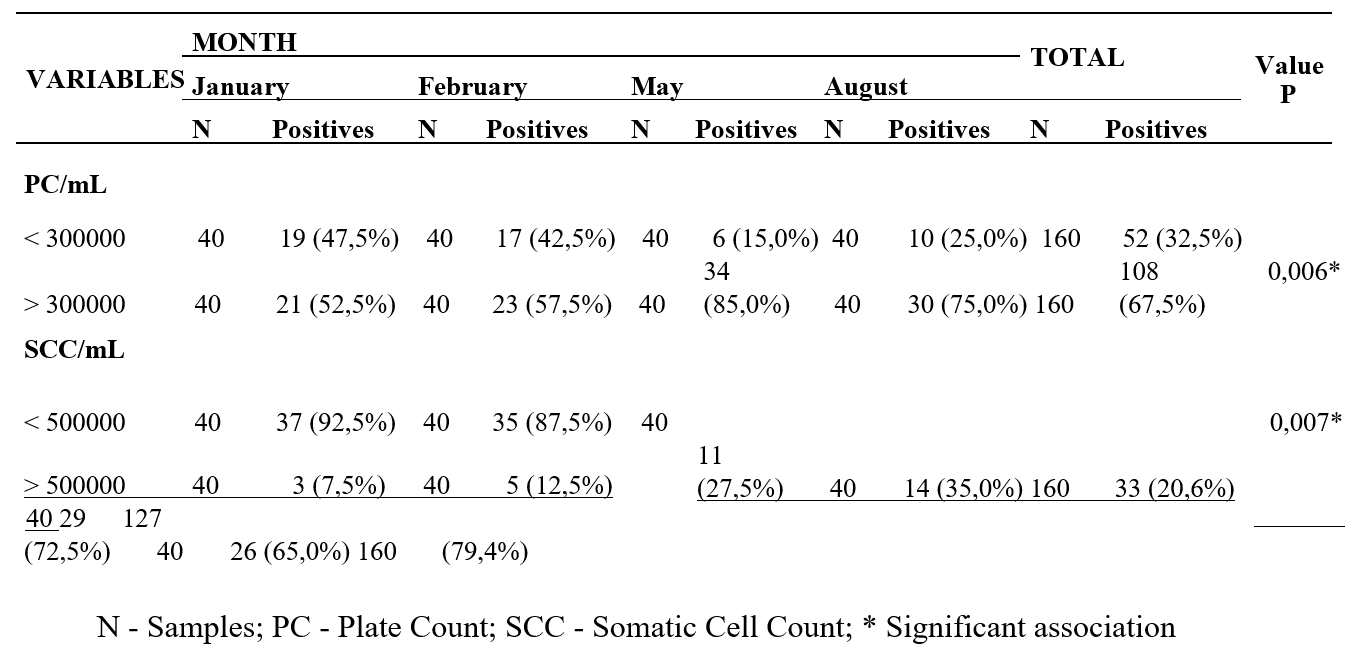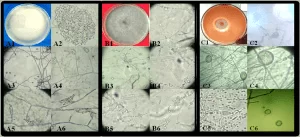ORIGINAL ARTICLE
SOARES, Karla Danielle Almeida [1], ALVES, Elizabeth Simões do Amaral [2], SILVA, João Manoel da [3], ANDRADE, Andrezza Cavalcanti de [4], SILVA, Maria Goretti Varejão da [5], SILVA, Daniel Dias da [6], MOURA, Vilton Edson Figueiroa de [7], ROLIM, Maria Betânia de Queiroz [8], SOARES, Anísio Francisco [9], MEDEIROS, Elizabeth Sampaio de [10]
SOARES, Karla Danielle Almeida. et al. Bacterial count and somatic cell count in milk from community tanks in Alagoas. Revista Científica Multidisciplinar Núcleo do Conhecimento. Year 08, Ed. 12, Vol. 01, pp. 05-14. December 2023. ISSN: 2448-0959, Access link: https://www.nucleodoconhecimento.com.br/agronomy-en/community-tanks, DOI: 10.32749/nucleodoconhecimento.com.br/agronomy-en/community-tanks
ABSTRACT
Milk is a highly nutritious liquid produced by the mammary glands of cows, serving as a crucial food source for a significant portion of the population. Therefore, ensuring its quality and safety is essential. The purpose of this study is to evaluate the Plate Count and Somatic Cell Count of raw milk from community expansion tanks in the state of Alagoas. For the research, 160 milk samples were collected from mammary quarters in the months of January, February, May, and August 2013, across 23 municipalities covering the three mesoregions of the state of Alagoas. The samples were sent in appropriate containers to the Milk Quality Network Laboratory for Somatic Cell Count (SCC) and Plate Count (PC) analysis. After analysis, it was found that 79.4% (127/160) of the samples met the criteria established by legislation for SCC, while 20.6% (33/160) did not. For PC, 100% (160/160) of the samples were non-compliant with the limits set by legislation. The study highlighted a higher percentage of samples outside the SCC standard in August and the PC with the highest percentage of non-compliance occurring in May. The average SCC and PC for the studied regions showed a significant difference in SCC mean (748,235.3 cells/mL) in the East region, with no significant difference in PC, having the lowest mean (1,853,029.4 CFU/mL) compared to other regions. It was noted that 12.5% of the samples had a fat measurement outside the allowed range, total proteins ranged from 2.4 to 3.86 (g/100g), and the amount of lactose ranged from 3.42 to 5.42 (g/100g). Thus, it can be concluded that all samples were non-compliant with legislation for PC, particularly in the eastern region of the state, indicating issues with the milk extraction, preservation, or cooling process. Implementation of corrective and educational measures is suggested to improve the quality of the product.
Keywords: Animal Production, Mammary Gland Health, Food Safety.
1. INTRODUCTION
In Brazil, milk is considered of great importance in the agricultural sector, representing a significant factor in job creation and essential income distribution in Brazilian agriculture through the production of small properties. It is necessary for this sector to become sustainable and profitable to meet the quality standards required for the production of refrigerated raw milk (Ströher; Santos Júnior; Salazar, 2023).
As a result, the market is becoming increasingly competitive, and one of the major challenges for the consolidation and development of the dairy industry in Brazil, as well as related to remuneration for the milk production chain, is the hygienic-sanitary quality of the raw material concerning high Plate Count (PC) and Somatic Cell Count (SCC) (Carneiro; Sousa; Ribeiro, 2023).
The Plate Count (PC) of refrigerated raw milk is a technique recognized by the International Dairy Federation (IDF). Thus, it is an essential analysis to identify deteriorating bacteria in raw milk, where a healthy mammary gland has an average PC that can vary from 100 to 43,000 CFU/mL (Mesquita et al., 2018).
One of the parameters for evaluating the microbiological quality of milk is the Somatic Cell Count (SCC), which can be elevated in cases of mastitis, a common inflammation in dairy farming that affects the mammary gland and can also cause other changes in the composition of milk, such as fat, protein, and lactose, leading to a reduction in these components (Domenico et al., 2023).
Currently, the Ministério da Agricultura, Pecuária e Abastecimento (MAPA) has established Normative Instructions No. 76 and No. 77 that guide the quality of milk, setting a maximum limit for Plate Count (PC) and Somatic Cell Count (SCC) parameters. There are no deadlines and increasing quality requirements, as in previous regulations (Brazil, 2018a; Brazil, 2018b). Thus, MAPA expects that more solid foundations will be created for a progressive evolution towards improving the quality of milk in the country (Silva et al., 2023). Therefore, the purpose of this study is to evaluate the Plate Count and Somatic Cell Count of raw milk from community expansion tanks in the state of Alagoas.
2. METHODOLOGY
160 milk samples were collected between January and August 2013, in the months of January, February, May, and August. All samples originated from expansion tanks of a dairy cooperative in Alagoas, encompassing 23 municipalities belonging to the three mesoregions of the state (Agreste Alagoano, Leste Alagoano, and Sertão Alagoano), with Agreste Alagoano having the highest number of research municipalities, and the largest quantity of samples coming from the eastern region of the state. For SCC analyses, samples were placed in bottles containing the preservative Bronopol® (2-bromo-2-nitropropane-1,3-diol), and for PC analyses, the preservative azidiol was used. Samples were transported under refrigeration for analysis at the laboratory of the Brazilian Milk Quality Network (RBQL) located at the Federal Rural University of Pernambuco. SCC analysis utilized the electronic equipment SomaScope – MK2 using the flow cytometry method according to ISO 13366-2 (IDF 148-2) calibrated to ISO 13366-1 (IDF 148-1). PC analysis was performed using the BactoCount IBC equipment, which also employs flow cytometry, with conversion to standard plate count anchored to the reference method ISO 4833-1 according to ISO 21187 (IDF 196).
The results obtained in the study were statistically tabulated using descriptive statistics, including relative and absolute frequencies, means, and standard deviations. Concerning the evaluation of the association between the investigated findings and the context of the collections, a univariate inquiry was conducted using the Chi-square test. To compare the findings regarding Somatic Cell Count (SCC) and Plate Count (PC) in relation to regions and months, the Tukey test was employed (Sampaio, 1998). Statistical calculations were performed using the SPSS for Windows program, version 19.0 – Statistical Package for the Social Sciences.
3. RESULTS AND DISCUSSION
In the study, it was elucidated that only 20.6% (33/160) of the analyzed samples were outside the standard established by legislation for SCC, and 32.5% (52/160) of the samples were in compliance with the legislation for PC, while 67.5% (108/160) were non-compliant (Table 1).
According to the current Normative Instruction No. 76 of November 26, 2018, the established limit for Somatic Cell Count is 500,000 cells/mL, and for Plate Count, it is 300,000 CFU/mL (Brazil, 2018) (Table 1).
Table 1 – Results of the parameters analyzed in milk samples from expansion tanks from properties in the state of Alagoas, 2013

High Somatic Cell Counts reflect the occurrence of mastitis in the herd, and despite producers claiming that there were no cases of mastitis during the research, the results obtained suggest the occurrence of this condition in the herd.
Therefore, SCC is used as a parameter for milk quality and mastitis prevention. In a comparative study of milk quality in the state of Minas Gerais by Carneiro; Sousa, and Ribeiro (2023), they found SCC values ranging from 130,000 cells/mL to 707,000 cells/mL on quarterly averages. Thus, a high SCC in a cow’s milk probably indicates that in at least one quarter of the udder, there was bacterial invasion, causing inflammation and mastitis occurrence. This is because somatic cells are the animal’s defense blood cells that move to the udder, resulting in a production decrease (Oliveira et al., 2019).
According to Rodrigues et al. (2023), in their study on Dairy Cattle Management for the Production of Refrigerated Raw Milk, other factors can also contribute to milk quality and the absence of microbiological contamination, highlighting the triad of reproductive, nutritional, and sanitary management of the herd.
The results obtained in the analysis of samples outside the standards for SCC were higher during the month of August, and this fact can be attributed to the rainy season, which is associated with a higher incidence of mastitis. The average SCC in that month was 801,300 cells/mL, and there was a significant difference compared to other months (Table 2).
Table 2 – Comparison between the averages of SCC and PC values concerning the studied months

The Somatic Cell Count (SCC) indicates the health status of the mammary gland, reflecting events when there is a bacterial infection or inflammatory process affecting the mammary tissue. The number of SCC inevitably increases in milk due to the migration of white blood cells to protect the mammary gland against bacterial challenges. Therefore, reducing SCC is more complex in the medium and long term (Felipus et al., 2023).
The Plate Count should be a maximum of 300,000 CFU/mL, and the results obtained in the research showed that the comparisons between the averages of PC values were all outside the standard. There was a focus on the highest percentage of non-compliance occurring in May, which may be related to water scarcity in some areas due to drought, contributing to an average PC of 2,669,275 CFU/mL, the highest compared to other months. Another important factor is the water source used for equipment and utensil cleaning, especially in drought-affected areas, where water was observed being used for animal consumption and facility cleaning. This situation can lead to significant contamination by microorganisms such as coliforms, directly compromising the quality of the raw material.
The results of the average SCC and PC by the studied region showed a significant difference in the SCC mean in the eastern region of the state compared to the others, with a value of 748,235.3 cells/mL (Table 3).
Table 3 – Comparison between the averages of SCC and PC values concerning the studied regions

All PC values in the studied regions showed non-compliance with Normative Instructions No. 76 and 77, which address the stages of refrigerated raw milk production and were implemented nationwide in 2019. The eastern region had the lowest PC average of 1,853,029.4 CFU/mL, but there was no significant difference between the other values. The characteristics of the mesoregions of the state of Alagoas reflect favorability for rainfall in the eastern region, while the agreste and sertão regions are characterized by less rainfall and more droughts. The high PC observed in these regions may be influenced by drought, where many tanks faced difficulties in water supply, compromising the effectiveness of the cleaning and sanitation process.
The increase in PC can be caused by the proliferation of bacteria from improper cleaning of milking equipment, leading to the formation of biofilms that increase milk contamination with resistant and deteriorating bacteria (Dias et al., 2020). Thus, we can relate that PC is a direct measure of milk contamination, while SCC is an indirect measure of inflammation or infection of the mammary gland (Bozo et al., 2013).
According to Müller (2021), milk quality is evaluated through physicochemical parameters, the absence or presence of chemical residues, milk obtaining and storage conditions, as well as milk composition, analyzing the percentage of fat, protein, and lactose.
Regarding the composition of refrigerated raw milk, physicochemical parameters must comply with IN 76, which establishes the minimum value of fat content as 3.0g/100g. In this study, the values ranged from 2.74 to 5.89 (g/100g). Regarding the amount of lactose in the milk, the measured values ranged from 3.42 to 5.42 (g/100g), with an average of 4.1 (g/100g), where the minimum content of anhydrous lactose recommended in IN 76 is 4.3g/100g. In terms of protein analysis in this study, the values ranged between 2.4 to 3.86 (g/100g), where the minimum content recommended by IN 76 for total protein is 2.9g/100g. Thus, only 12.5% (20/160) of the samples were outside the minimum value for the allowed physicochemical parameters.
4. CONCLUSION
In conclusion, this study reveals that the highest percentage of samples was outside the limits established by Normative Instructions No. 76 and 77, which address the stages of refrigerated raw milk production. The averages found were high, especially in the eastern region of the state, indicating hygienic failures in milk obtaining, handling, or cooling. Thus, the implementation of corrective and educational measures across the entire dairy production chain is recommended to promote and ensure a better-quality product.
5. ACKNOWLEDGMENTS
The present work was carried out with the support of the Coordenação de Aperfeiçoamento de Pessoal de Nível Superior – Brazil (CAPES) – Financing Code 001 and the Universidade Federal Rural de Pernambuco (UFRPE).
REFERENCES
BRASIL. Instrução Normativa n°76 de 26 de novembro de 2018. Diário Oficial da União, Brasília: Ministério da Agricultura, Pecuária e Abastecimento/Secretaria de Defesa Agropecuária, 2018a
BRASIL. Instrução Normativa n°77 de 26 de novembro de 2018. Diário Oficial da União, Brasília: Ministério da Agricultura, Pecuária e Abastecimento/Secretaria de Defesa Agropecuária, 2018b.
BOZO, G. A. et al. Adequação da contagem de células somáticas e da contagem bacteriana total em leite cru refrigerado aos parâmetros da legislação. Arquivo Brasileiro de Medicina Veterinária e Zootecnia, v. 65, n. 2, p. 589-594, 2013.
CARNEIRO, I. A.; SOUSA, F. A.; RIBEIRO, G. L. Qualidade de Leite: Estudo Comparativo de Padrões Microbiológicos. Revista Educação Saúde & Meio Ambiente, Patrocínio, v. 2, n. 13, p. 761-772, 2023.
DIAS, J.A.; BELOTI, V.; DE OLIVEIRA, A. M. Ordenha e boas práticas de produção. Embrapa Rondônia-Capítulo em livro técnico (INFOTECA-E), 2020.
DOMENICO, V. L. D. et al. Ciência Animal Brasileira, V24, e-75499P, 2023.
FELIPUS, N. C. et al. Quality of refrigerated raw milk according to the bulk transport conditions. Acta Scientiarum. Animal Sciences, v. 45, p. e58353, 2023.
MESQUITA, A. A. et al. Contagem bacteriana total e contagem de células somáticas como indicadores de perdas de produção de leite. Pubvet, v.12, n.6, p.1-8, 2018.
MÜLLER, T. R. C. Qualidade do leite bovino produzido no Brasil – parâmetros físico-químicos e microbiológicos: uma revisão integrativa. Visa em Debate, Sociedade, Ciência e Tecnologia, 9(3):122-129, 2021.
OLIVEIRA, S. C. C. et al. Extratos de plantas brasileiras no controle da bactéria Staphylococcus aureus causadora da mastite contagiosa em bovinos leiteiros. Revista Tecnológica, v. 27(1), 48–58. 2019.
RODRIGUES, L. R. F. P. et al. Manejo de vacas leiteiras para produção de leite cru refrigerado. Revista Universitária Brasileira, v.1(1): 101–116, 2023.
SAMPAIO, I. B. M. Estatística aplicada à experimentação animal. Belo Horizonte: Fundação de Ensino e Pesquisa em Medicina Veterinária e Zootecnia, 221p, 1998.
SILVA, I. A. et al. Condições Higiênico-Sanitárias em rebanho bovino Leiteiro no município de Vitorino Freire/MA. Revista Científica Multidisciplinar, v. 4, n. 4, p. e442996, 2023.
STRÖHER, J. A.; SANTOS JÚNIOR, L. C. O.; SALAZAR, M. M. Avaliação da qualidade microbiológica do leite cru refrigerado no trajeto do campo à indústria: estudo de caso no Rio Grande do Sul. Revista de Nutrição e Vigilância em Saúde, v.10:e11064, 2023.
[1] PhD in Animal Bioscience. ORCID: https://orcid.org/0000-0003-2473-9451. Currículo Lattes: http://lattes.cnpq.br/5770903127454350.
[2] PhD Candidate in Animal Bioscience. ORCID: https://orcid.org/0000-0001-5078-4104. Currículo Lattes: https://lattes.cnpq.br/2775935070259137.
[3] PhD in Agricultural Biotechnology from the Northeast Biotechnology Network (RENORBIO). ORCID: https://orcid.org/0000-0002-7654-5475. Currículo Lattes: http://lattes.cnpq.br/2574390886279350.
[4] Master’s in Animal Science. ORCID: https://orcid.org/0000-0002-7067-3855. Currículo Lattes: https://lattes.cnpq.br/7795984886994762.
[5] PhD candidate in the Animal Bioscience Graduate Program. ORCID: 0000-0001-9410-7631. Currículo Lattes: http://lattes.cnpq.br/4532231119888940.
[6] M.Sc. in Animal Bioscience. ORCID: 0000-0002-4913-8313. Currículo Lattes: http://lattes.cnpq.br/4967459162060058.
[7] Undergraduate student in Bachelor of Biological Sciences. ORCID: 0000-0001-7149-4931. Currículo Lattes: https://lattes.cnpq.br/2928291078391850.
[8] Ph.D. in Veterinary Medicine. ORCID: https://orcid.org/0000-0002-0072-5103. Currículo Lattes: http://lattes.cnpq.br/8207812492517198.
[9] PhD in Biochemistry and Physiology, Master’s in Physiology, Biologist. ORCID: 0000-0003-1493-7964. Currículo Lattes: http://lattes.cnpq.br/9044747136928972.
[10] Supervisor. PhD in the Animal Bioscience Graduate Program. ORCID: 0000-0002-1289-2902. Currículo Lattes: http://lattes.cnpq.br/5998863169551704.
Submitted: September 1, 2023.
Approved: September 15, 2023.





